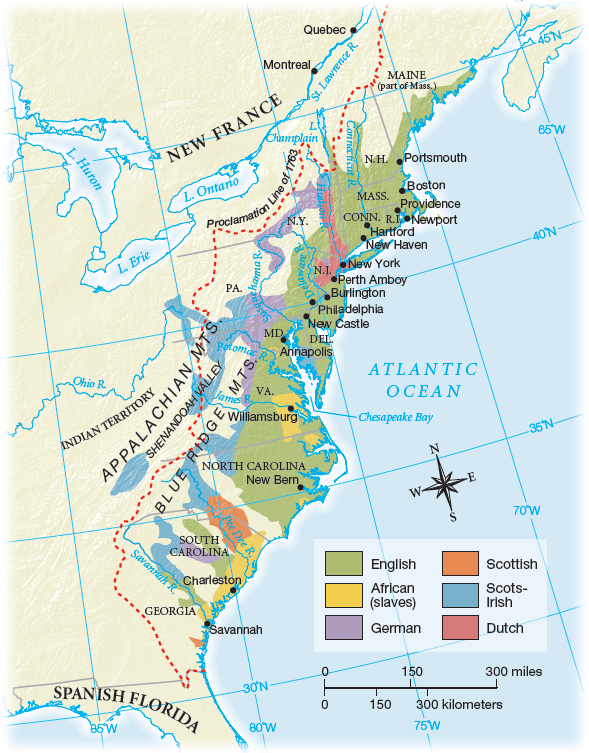How did the North American colonies change in the eighteenth century?
Printed Page 112
THE MOST IMPORTANT FACT about eighteenth-century British America is its phenomenal population growth: from about 250,000 in 1700 to over two million by 1770. The eightfold growth of the colonial population signaled the maturation of a distinctive colonial society. Colonists of different ethnic groups, races, and religions lived in varied environments under thirteen different colonial governments, all of them part of the British empire.

natural increase
 The growth of population through reproduction, as opposed to immigration. In the eighteenth century, natural increase accounted for about three-fourths of the American colonies’ population growth.
The growth of population through reproduction, as opposed to immigration. In the eighteenth century, natural increase accounted for about three-fourths of the American colonies’ population growth.
KEY FACTORS
In 1770
– Colonial population had grown to two million, compared with 250,000 in 1700.
– About half of American colonists were of English descent, while more than 20 percent were of African descent.
In general, the growth and diversity of the eighteenth-century colonial population derived from two sources: immigration and natural increase (growth through reproduction). Natural increase contributed about three-fourths of the population growth, immigration about one-fourth. Immigration shifted the ethnic and racial balance among the colonists, making them by 1770 less English and less white than ever before. Fewer than 10 percent of eighteenth-century immigrants came from England; about 36 percent were Scots-Irish, mostly from northern Ireland; 33 percent arrived from Africa, almost all of them slaves; nearly 15 percent had emigrated from the many German-language principalities (the nation of Germany did not exist until 1871); and almost 10 percent came from Scotland. In 1670, more than 9 out of 10 colonists were of English ancestry, and only 1 out of 25 was of African ancestry. By 1770, only about half of the colonists were of English descent, while more than 20 percent descended from Africans. Thus, by 1770, the people of the colonies had a distinctive colonial — rather than English — profile (Map 5.1).

The booming population of the colonies hints at a second major feature of eighteenth-century colonial society: an expanding economy. The nearly limitless wilderness stretching westward made land relatively cheap compared with its price in the Old World. The abundance of land made labor precious, and the colonists always needed more. The insatiable demand for labor was the fundamental economic environment that sustained the mushrooming population. Economic historians estimate that free colonists (those who were not indentured servants or slaves) had a higher standard of living than the majority of people elsewhere in the Atlantic world.
QUICK REVIEW
Question
1w8MCsUusdmtjsnhnyD5eP0jy6jjkFaVMmHsain+sw5rp6oMYoXtzNXuRb/FChB5o6/aAqh+GpaKvxLL5Auh+hxyyw7yP4xM9wmPsFaFd4qX1oVHBaC+ooX10ce7mUqg98ALaiZcdg+5IfQkCHAPTER LOCATOR
How did the North American colonies change in the eighteenth century?
What changed in New England life and culture?
What spurred the growth of the middle colonies?
Why did slavery become the defining feature of the southern colonies?
What experiences tended to unify colonists in British North America?
Conclusion: What was the dual identity of British North American colonists?
 LearningCurve
LearningCurve
Check what you know.